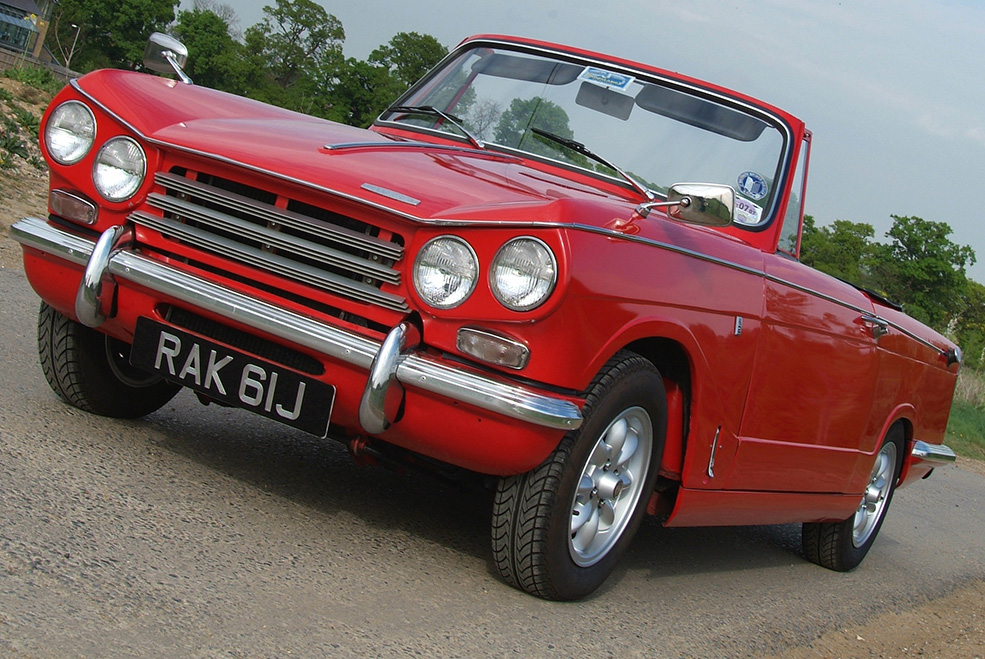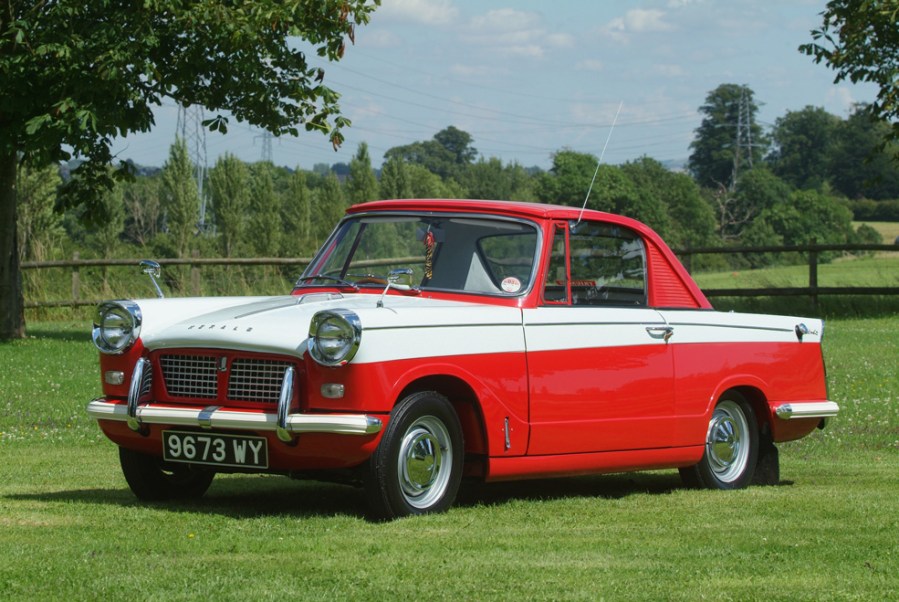Triumph produced a winner with the Herald and built on the success with the six-cylinder Vitesse. Variants include saloons, convertibles, estates and vans and the Herald’s chassis on frame construction means that restoring one these very useable cars is well within the bounds of a keen DIY owner.
Here are 10 interesting facts about the Herald you may not know…
1. So, why did the Herald use a separate chassis? It was because BMC owned Fisher and Ludlow and were becoming a pain to deal with. Triumph had no option but to use a chassis on which to build a body that was basically bolted together thus enabling various body styles at minimal cost. Triumph bosses got their own back on BMC in the BMH merger though!
2. What was the Herald Coupe all about? Because the roof was a bolt on panel, Triumph could alter body styles at will and the main body tub is all but identical. However, the Coupè – despite being the ‘looker’ in the range – was not a great success and was discontinued in 1964, as it was felt that it provided internal competition against both the Spitfire and the Vitesse models.
3. Was the Herald a sales success? Yes and no. The Herald was expensive and time consuming to build and the resulting 1959 launch price of £700 put it out of contention with the £500 Mini and £600 Anglia. The Mini had a slow start but the Anglia flew out of showrooms. Nearly 200,000 were sold in 1960, three times as many as the Herald. The cars 1961 relaunch as a 1200 helped it though.
4. Why was the Herald a Triumph and not a Standard? Standard Triumph knew then that there was value in a brand. Standard made cheap and cheerful saloons, the Triumph name meant the TR3. If they were going to ask 700 quid for a 948cc car, it needed the right image. After that, the Standard name and it’s downmarket connotations was phased out by the final Vanguard in 1963.
5. Was the wooden dash an attempt to justify the high price? No, because the original 948cc cars didn’t have one – instead, the dash was a pressing made from dark grey fibreboard. A wood veneer dash panel was an option on early cars but by the time the 1200 arrived, it had been phased in as a standard feature (no pun intended!) and it became a well known Herald trademark.
6. What about the later Indian built cars? Standard Triumph set up an assembly plant in Madras in the early ‘Sixties to build cars from CKD (complete knock down) kits although as time went on, more autonomy and locally made parts were used. A four-door version was made called the Standard Gazel and this continued in production until 1977 with a solid Triumph Toledo rear axle.
7. Why was the early Vitesse a 1600? This was due to Triumph concern over the 2.0 litre unit from the 2000 being too much. The Vitesse used front discs and a reinforced chassis, the latter phased in for Herald production for 1963. The 1600 straight six was very smooth and gave 70bhp. Many enthusiasts think it was a nicer package than the faster 2000 that tested the rear suspension design to the limit.
8. Did Triumph ever sort the handling problems? Yes, to a large extent. Like the original GT6 Triumph was stung by criticism with a car that really shouldn’t have been launched in that form. The 1967 MII had a revised rear suspension with new lower wishbones, Rotoflex driveshaft couplings and rear camber changes reduced from an alarming 15 degrees to just five degrees.
9. What are the main weak points of these cars? Not a lot, they didn’t drop to bits with rust like the Anglia or an 1100 and mechanically they were tough. Tired engines, worn driveshafts, rusty arches, rotten chassis outriggers were common but decent cars will have been doctored by now. There are others though, as Convertible doors can fly open on corners if the catches are worn out!
10. How many Heralds were built in the end? 521,000 Heralds were built of all types, as well as 51,000 Vitesses. Compare that to the Mini and 1100. By 1965 BMC had built a million Minis (two million by 1969) and the 1100/1300 range chalked up over two million units. Ford sold a million Cortinas in four years but he Herald’s construction meant it just took too long to build.

A brief history of the Triumph Herald & Vitesse…
Launched in 1959 and joined in 1962 by a six cylinder Vitesse (‘speed’), the Triumph Herald was certainly an oddball design for 1959. Complete with tail fins, it looked modern for the time but compared to the Mini, Cortina and 1100 of 1962, it would soon date quite rapidly. But it was a reasonably good seller and the 1965 Triumph 1300 that should really have replaced it did not and it motored on until 1971 when cars such as the Fiat 128 were being imported.
Popular with driving schools due to the amazingly small turning circle, the Herald was easy to drive with a light clutch and gear change, although fast drivers didn’t like it much – a play on the Christmas carol ‘Hark the Herald, Axle Swing’ was a well used joke owing to the way the rear swing axles could tuck under during fast cornering causing embarrassment if not an accident. Using the Standard 10 948cc OHV engine – a decent little unit and comparable to the BMC A-Series – the Herald was very unusual in using a separate chassis when Ford was just abandoning it the year the Herald was launched with the ancient E493A sit up and beg Popular. BMC hadn’t used a separate chassis since the days of the old A40 Somerset.
Heralds still aren’t worth a lot, although nice Convertible models are fetching a reasonable sum. Really tidy saloons are £3000 (double that for a show car) and that buys a reliable and presentable Convertible if not a minter – those are £5000-£6000. The Vitesse cars are worth more of course – £5000 for a good solid car ready to use rising to £10,000 for a show car. Most desirable? Probably the early Herald Coupè are, easily the best-looking cars with a fabulous late ‘Fifties charm. Good luck finding one of those!
So here’s a quick Herald timeline: The car was launched in April 1959 as a Saloon or Coupè with the Convertible arriving in 1960. The 1200 arrived in 1961 with a slow selling Estate arriving soon after and the even slower selling Courier van launched in 1962 – it was dropped in 1964 with CKD production in Malta until 1966. Coupe production ended in 1964. The 12/50 arrived in 1963 and was popular – 12/50 means 1200 cc and around 50bhp (51 to be exact) and the car featured a fold back sunroof, front discs from the Vitesse plus a fine mesh alloy grille and was only sold as a saloon. Shortly after, the standard Herald 1200 was boosted to 48bhp.
The 13/60 arrived in 1967 with the 1300 engine and effectively replaced the other Herald variants, although the basic 1200 persevered until 1970 with slow sales. The 13/60 used a 61bhp 1300 engine that was also used in the 1300 saloon and Spitfire and featured a new single headlight variant of the Vitesse bonnet and front disc brakes. Saloon production ended in December 1970 (replaced by the worthy and popular Toledo) with the Estate and Convertible lasting another six months. The Vitesse 6 was launched in 1962, became a 2.0 litre in 1966 and was revised as the MkII in 1967. Production ended in July 1971.






